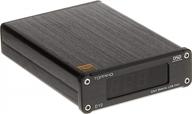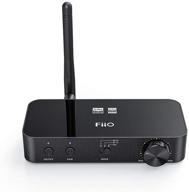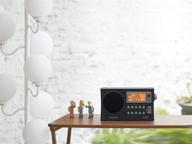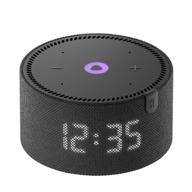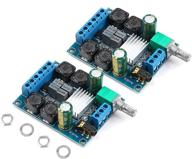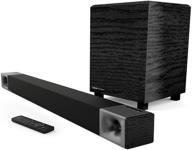Top products in 🍿 Home Theater
Choosing the Right Home Theater System
Building a home theater system can be an exciting project, but with so many components to choose from, it can also feel overwhelming. Follow this guide to learn what you need to think about when selecting the right home theater system for your space and needs.
Types of Home Theater Systems
Home theater systems generally fall into a few main setups:
- 2.1 systems - Left and right front speakers with a subwoofer
- 5.1 systems - Front left and right, center, and left and right surround speakers, plus a subwoofer
- 7.1 systems - 5.1 system plus left and right rear surround speakers
5.1 and 7.1 surround sound configurations provide a more immersive experience by surrounding you in sound. However, start with the number of speakers your room can accommodate.
Another interesting products
Choosing Speakers
Your speakers are the most important part of any home theater. There are several specs to consider when selecting speakers:
- Driver size - Larger woofers and tweeters can handle more power and produce louder, deeper sound.
- Frequency response - The range of bass and treble a speaker can produce. Look for a range close to 20Hz-20kHz.
- Impedance - Most home speakers are 6 or 8 ohms. Get speakers with impedance matching your receiver.
- Sensitivity - Measured in dB, this determines how loudly a speaker plays with power. 87dB or higher is ideal.
Be prepared to spend more on your front left, right, and center channel speakers since these handle most of the audio.
Choosing an AV Receiver
The AV (audio/video) receiver powers all of your speakers and acts as the central hub of your home theater. When selecting one, match the power output and number of channels to your speakers. Other key features include:
| Feature | What to Look For |
|---|---|
| HDMI ports | At least 3-4 ports for your video sources |
| 4K/HDR compatibility | For 4K video and HDR color/contrast |
| Surround sound formats | Dolby Atmos, DTS:X for 3D, immersive audio |
| Audio calibration | To properly tune your system |
Choosing Your Display
When selecting a TV or projector, look for:
- 4K resolution
- High contrast ratio and peak brightness
- HDR support
- Low input lag when gaming
- Viewing angle and screen size for your room
A projector can offer an enormous, cinematic image, but requires more space. TVs are convenient but limited in size.
Similar products
Other Components
To complete your home theater setup, you'll also need:
- Media streamer - For streaming movies and shows through apps
- Blu-ray player - For playing Blu-ray movies
- Gaming console - To play video games on the big screen
- Universal remote - For easily controlling everything
- Speaker stands/mounts - To properly position your surround speakers
- Speaker wire - For connecting your speakers to the receiver
- HDMI cables - For your video components
Take the time to carefully plan each element of your home theater system. The investment will be well worth it when you get to enjoy your favorite movies, shows, and games on your own big screen with incredible surround sound.
Types of Home Theater Systems
Home theater systems come in different configurations to suit rooms of any size and budget. Here is an overview of the most common types of home theater setups.
Stereo (2.0/2.1) Systems
A stereo or 2.0 home theater system contains just two speakers - a left and a right front speaker. This creates a simple, two-channel setup for enjoying music or TV shows. A 2.1 system adds a subwoofer for deeper bass.
Example 2.1 system:
- Left and right bookshelf speakers - $400
- Powered subwoofer - $200
- AV receiver with 90 watts/channel - $250
- Total: $850
Stereo systems are affordable and easy to set up in small spaces like apartments or bedrooms. However, they lack surround sound capabilities for a truly immersive experience.
5.1 Surround Sound Systems
A 5.1 home theater includes left, center, and right front speakers, left and right surround speakers, and a subwoofer. The "5" refers to the number of speakers and the ".1" refers to the subwoofer.
Example 5.1 system:
- 3 front speakers - $500
- 2 surround speakers - $300
- Powered subwoofer - $350
- 7.2 channel AV receiver - $450
- Total: $1600
This surround sound setup creates an immersive 360-degree audio experience. The center channel ensures clear dialog. 5.1 works well for medium-sized home theaters.
7.1 Surround Sound Systems
A 7.1 home theater system adds left and right rear surround speakers to a basic 5.1 setup. This provides an even more enveloping surround sound environment.
Example 7.1 system:
- 5 front/surround speakers - $650
- 2 rear surround speakers - $300
- Powered subwoofer - $400
- 9.2 channel AV receiver - $650
- Total: $2000
The two extra rear channels let you hear sounds behind you, like planes flying overhead. It's worth the investment for larger dedicated home theaters.
Dolby Atmos Systems
Dolby Atmos home theater systems add height channels through special upward-firing speakers. These create immersive 3D audio that comes from all around you, even above you.
Example 5.1.2 Atmos system:
- 5 ear-level speakers - $800
- 2 Atmos height speakers - $500
- Powered subwoofer - $500
- Dolby Atmos AV receiver - $800
- Total: $2600
The ".2" here refers to the 2 height channels. Dolby Atmos enables advanced 3D sound effects like aircraft flying overhead, for a truly cinematic experience.
Whole Home Audio Systems
You can extend your home theater audio system to the entire house using multi-room audio. This allows you to play the same music or home theater sound in any room with speakers.
Example whole home setup:
- 7.1 home theater system - $2000
- Multi-room speakers - $1200
- Multi-channel amp - $500
- Total: $3700
Whole home audio systems let you enjoy your home theater sound anywhere, whether you're lounging by the pool or cooking in the kitchen.
Choosing the right home theater system comes down to room size, budget, and the type of audio experience you want. Plan carefully and you'll enjoy immersive entertainment for years to come.
Home Theater Speakers
The right set of speakers can make or break your home theater experience. Here's an overview of the different types of speakers used in home theater systems and what to look for when choosing them.
Front Speakers
Your front left, center, and right speakers handle the majority of sound effects and dialogue. For the best quality, choose front speakers with:
- 5-7 inch woofers for strong bass
- 1-1.5 inch tweeters for crisp highs
- High sensitivity - 89dB or higher
- Wide frequency response - at least 45Hz to 20kHz
Floorstanding tower speakers work well for front channels thanks to larger woofers. High quality bookshelf speakers can also deliver solid performance for smaller rooms. Expect to spend more on your front three speakers since these do the most sonic heavy lifting.
Center Channel Speaker
This is dedicated to dialogue and is the most important speaker for TV shows and movies. Place it directly below or above your TV. Look for center speakers with:
- Dual or triple 5-7 inch woofers
- Horizontal (or coaxial) driver alignment to disperse sound widely
- Shielded drivers if placing near a TV screen
Surround Sound Speakers
Surround speakers placed to the sides and rear of the viewing position fill in ambient effects and improve spatial imaging. For surrounds, choose:
- Compact bookshelf or wall-mountable speakers
- Smaller 4-6 inch woofers fine since these won't handle heavy effects
- Aim slightly downward toward the listening area
Dipolar surround speakers with angled driver layouts do a great job of dispersing non-directional ambient audio.
Subwoofers
No home theater is complete without a subwoofer to handle deep bass like explosions or LFE (low frequency effects) tracks. Look for subs with:
- High continuous and peak power - at least 300 watts or more
- Large driver size - 12-15 inches ideally
- Front or down-firing position - avoid rear-firing subs
- Adjustable crossover to blend with speakers
One powerful sub is usually enough for most setups. Place it up front near the center speaker. Adding a second sub can help eliminate nulls and improve bass response.
Atmos Enabled Speakers
To enjoy Dolby Atmos and DTS:X 3D audio formats, you'll need special height speakers that bounce sound off the ceiling. These include:
- Up-firing speakers placed atop floorstanding front speakers
- Bounce speakers aimed at the ceiling
- Ceiling-mounted speakers for the most direct overhead sound
Atmos enabled speakers help create immersive, three-dimensional audio with effects coming from above.
| Speaker Type | Typical Price Range |
|---|---|
| Floorstanding Speakers | $500 - $3000 per pair |
| Bookshelf Speakers | $200 - $1000 per pair |
| Center Channel Speakers | $150 - $700 each |
| Surround Speakers | $100 - $600 per pair |
| Subwoofers | $300 - $1500 each |
| Atmos Height Speakers | $200 - $1000 per pair |
Shop carefully, read reviews, and demo speakers when possible. Quality speakers matched to your room's size will make your home theater sound incredible for many years of enjoyment.
Home Theater Receivers
The AV receiver is the heart of your home theater system, powering all your speakers while handling video switching capabilities. Here's what to look for when shopping for an AV receiver.
Channels
A receiver's channels refer to its amplification power - how many speakers it can drive. Choose a receiver with enough channels for your speaker setup:
- 5 channels for a basic 5.1 system
- 7 channels for a 5.1 setup with extra surrounds
- 9 channels to power front, surround, and height speakers in a 7.1.2 Atmos system
- 11 channels for larger 9.1.2 configurations
Make sure your receiver has sufficient wattage per channel. Look for at least 80 watts per channel for efficient speakers and 100+ watts for power hungry speakers.
Video Connectivity
Your receiver should have multiple HDMI inputs and outputs to connect your video sources and TV. Key features include:
- 4K video passthrough for Ultra HD televisions and media players
- HDMI 2.1 support for 8K video, HDR, and higher frame rates
- HDCP 2.2 copy protection on all ports
- Enough inputs for your Blu-ray player, game console, streaming device, etc.
ARC (audio return channel) allows sending audio from your TV back through one HDMI cable. eARC builds on this for lossless surround sound formats.
Audio Formats
Ensure your receiver can decode all the latest surround sound formats for proper playback:
- Dolby Atmos - Brings 3D, immersive audio
- DTS:X - Competing 3D audio format to Atmos
- DTS-HD Master Audio - Found on Blu-ray discs
- Flac, WAV, ALAC - For high resolution audio files
The more audio formats supported, the more future-proof your receiver will be.
Connectivity and Streaming
Look for receivers that offer:
- Wi-Fi and Ethernet - For smart platforms and wireless streaming
- Bluetooth - To wirelessly play music from your phone or tablet
- Multi-room audio - For extending sound to other rooms
- AirPlay, Chromecast, etc. - For easy streaming from apps
- Voice control - Via Alexa, Siri, Google Assistant
These streaming capabilities let you enjoy music services like Spotify, Pandora, Tidal, and more.
Sound Processing
Your receiver should include auto speaker calibration with a microphone to optimize sound for your specific room. Other useful sound modes include:
- Audyssey, YPAO, MCACC, etc. - Auto EQ/calibration systems
- Upmixing - For expanding stereo audio to surround sound
- Dialog enhancement - For clearer speech
- Multiple EQ curves - To tailor sound profile
These adjustments help tweak the sonic performance and can compensate for acoustic flaws in your room.
Choosing the right AV receiver ensures you have all the audio muscle and features needed for spectacular home theater sound.
What is the Use of Amazon Prime for Home Theater Shoppers?
For those looking to build or upgrade their home theater system, an Amazon Prime membership can be extremely valuable. Here are some of the key benefits Prime offers home theater buyers.
Free Fast Shipping
Amazon Prime provides free two-day shipping on millions of items. This means you can get all the gear you need for your home theater delivered quickly and without paying extra shipping fees.
Speakers, receivers, TVs - anything you purchase on Amazon over $25 qualifies for the fast free shipping perk. No more waiting over a week for components to arrive.
Free Returns
Amazon Prime also makes returns easy. You get free returns on most items within 30 days of delivery. This is extremely convenient if you are testing out different home theater products like speakers and receivers.
It lets you audition gear in your space without commitment. Return what doesn't meet your needs or quality standards.
Access to Exclusive Deals
Amazon Prime members get access to special discounts and sales throughout the year. This includes savings on select home theater products during sales events like Prime Day.
You can find significant deals on TVs, projectors, speakers, media streamers and other electronics. Prime makes gear more affordable.
Prime Video
A Prime membership provides access to Prime Video, Amazon's streaming video service. This grants you an extensive collection of movies and shows to enjoy on your new home theater setup.
You also get access to 4K and HDR content to showcase your UHD TV or projector. Prime Video lets you test your system's performance.
Extras Like Music and Books
On top of free shipping, returns, and video, an Amazon Prime subscription includes other perks like:
- Prime Music - Extensive streaming music catalog
- Prime Reading - Access to ebooks and magazines
- Prime Gaming - Free games, in-game content, and a Twitch subscription
These extras add even more entertainment options for your home theater.
For home theater enthusiasts, an Amazon Prime membership can be a highly valuable asset. The free fast shipping, returns, deals, and entertainment make it easier and more affordable to build your dream theater.
Components Of Home Theatre
A home theater system consists of several components that work together to create a cinematic experience in the comfort of your own home. Here are the essential components of a home theater system:
When setting up your home theater system, it's important to consider the size and layout of the room, as well as the amount of time that you plan to use it. A dedicated room with little ambient light from windows is ideal, but if you don’t have a basement or spare room to dedicate to your personal cinema, a home theater system and your family can comfortably coexist in your living room.
Best Home Theater System
There are many great home theater systems available in 2023, each with its own unique features and benefits. Here are six of the best home theater systems to consider:
- SVS Prime Satellite 5.1: This system offers compact speakers and great sound quality, making it a great choice for those who want good surround sound without breaking the bank.
- Enclave Audio CineHome HD 5.1: This wireless home theater system is easy to set up and offers great sound quality, making it a good choice for those who want a hassle-free setup.
- Polk Signature Elite ES15: This bookshelf speaker pair sounds great, looks cool, and is surprisingly affordable, making it a great choice for those on a budget.
- Sonos 5.1 Surround Set: This hassle-free home theater system is easy to set up and offers great sound quality, making it a good choice for those who want a simple setup.
- Q Acoustics 3050i 5.1 Cinema Pack: This system is boldly cinematic and hugely entertaining, and actually doesn't take up as much space as its sound might have you believe.
- Dali Oberon 5 5.1 Speaker Package: This system offers true 5.1 surround sound and impressive sound quality, making it a great choice for those who want a truly immersive experience.
When choosing a home theater system, it's important to consider your budget, the size of your room, and your personal preferences. Whether you're looking for a simple setup or a more immersive experience, there's a home theater system out there that's perfect for you.








